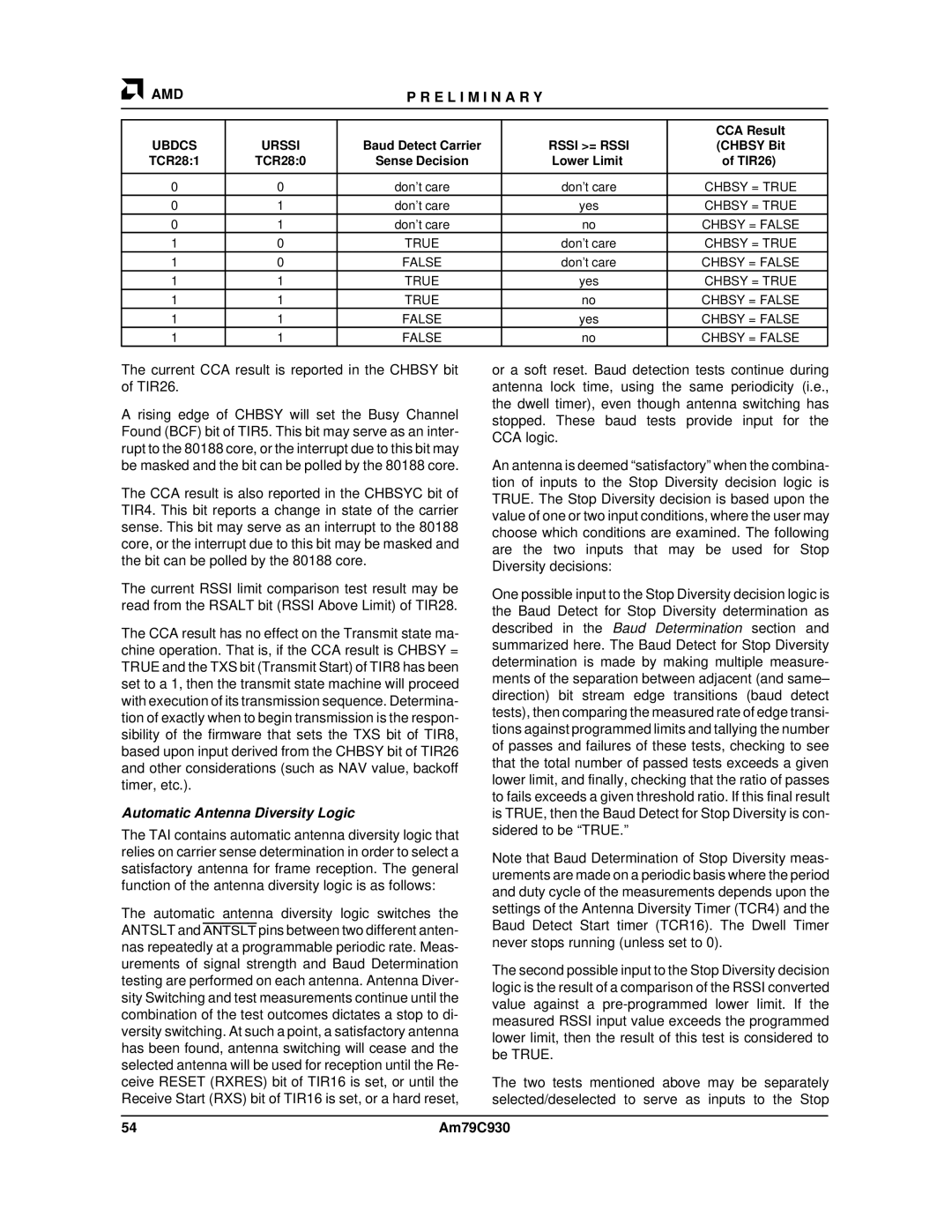
AMD |
| P R E L I M I N A R Y |
|
| |
|
|
|
|
|
|
|
|
|
|
|
|
|
|
|
|
| CCA Result |
UBDCS | URSSI | Baud Detect Carrier |
| RSSI >= RSSI | (CHBSY Bit |
TCR28:1 | TCR28:0 | Sense Decision |
| Lower Limit | of TIR26) |
|
|
|
|
|
|
0 | 0 | don't care |
| don't care | CHBSY = TRUE |
0 | 1 | don't care |
| yes | CHBSY = TRUE |
0 | 1 | don't care |
| no | CHBSY = FALSE |
1 | 0 | TRUE |
| don't care | CHBSY = TRUE |
1 | 0 | FALSE |
| don't care | CHBSY = FALSE |
1 | 1 | TRUE |
| yes | CHBSY = TRUE |
1 | 1 | TRUE |
| no | CHBSY = FALSE |
1 | 1 | FALSE |
| yes | CHBSY = FALSE |
1 | 1 | FALSE |
| no | CHBSY = FALSE |
The current CCA result is reported in the CHBSY bit of TIR26.
A rising edge of CHBSY will set the Busy Channel Found (BCF) bit of TIR5. This bit may serve as an inter- rupt to the 80188 core, or the interrupt due to this bit may be masked and the bit can be polled by the 80188 core.
The CCA result is also reported in the CHBSYC bit of TIR4. This bit reports a change in state of the carrier sense. This bit may serve as an interrupt to the 80188 core, or the interrupt due to this bit may be masked and the bit can be polled by the 80188 core.
The current RSSI limit comparison test result may be read from the RSALT bit (RSSI Above Limit) of TIR28.
The CCA result has no effect on the Transmit state ma- chine operation. That is, if the CCA result is CHBSY = TRUE and the TXS bit (Transmit Start) of TIR8 has been set to a 1, then the transmit state machine will proceed with execution of its transmission sequence. Determina- tion of exactly when to begin transmission is the respon- sibility of the firmware that sets the TXS bit of TIR8, based upon input derived from the CHBSY bit of TIR26 and other considerations (such as NAV value, backoff timer, etc.).
Automatic Antenna Diversity Logic
The TAI contains automatic antenna diversity logic that relies on carrier sense determination in order to select a satisfactory antenna for frame reception. The general function of the antenna diversity logic is as follows:
The automatic antenna diversity logic switches the ANTSLT and ANTSLT pins between two different anten- nas repeatedly at a programmable periodic rate. Meas- urements of signal strength and Baud Determination testing are performed on each antenna. Antenna Diver- sity Switching and test measurements continue until the combination of the test outcomes dictates a stop to di- versity switching. At such a point, a satisfactory antenna has been found, antenna switching will cease and the selected antenna will be used for reception until the Re- ceive RESET (RXRES) bit of TIR16 is set, or until the Receive Start (RXS) bit of TIR16 is set, or a hard reset,
or a soft reset. Baud detection tests continue during antenna lock time, using the same periodicity (i.e., the dwell timer), even though antenna switching has stopped. These baud tests provide input for the CCA logic.
An antenna is deemed “satisfactory” when the combina- tion of inputs to the Stop Diversity decision logic is TRUE. The Stop Diversity decision is based upon the value of one or two input conditions, where the user may choose which conditions are examined. The following are the two inputs that may be used for Stop Diversity decisions:
One possible input to the Stop Diversity decision logic is the Baud Detect for Stop Diversity determination as described in the Baud Determination section and summarized here. The Baud Detect for Stop Diversity determination is made by making multiple measure- ments of the separation between adjacent (and same– direction) bit stream edge transitions (baud detect tests), then comparing the measured rate of edge transi- tions against programmed limits and tallying the number of passes and failures of these tests, checking to see that the total number of passed tests exceeds a given lower limit, and finally, checking that the ratio of passes to fails exceeds a given threshold ratio. If this final result is TRUE, then the Baud Detect for Stop Diversity is con- sidered to be “TRUE.”
Note that Baud Determination of Stop Diversity meas- urements are made on a periodic basis where the period and duty cycle of the measurements depends upon the settings of the Antenna Diversity Timer (TCR4) and the Baud Detect Start timer (TCR16). The Dwell Timer never stops running (unless set to 0).
The second possible input to the Stop Diversity decision logic is the result of a comparison of the RSSI converted value against a
The two tests mentioned above may be separately selected/deselected to serve as inputs to the Stop
54 | Am79C930 |
